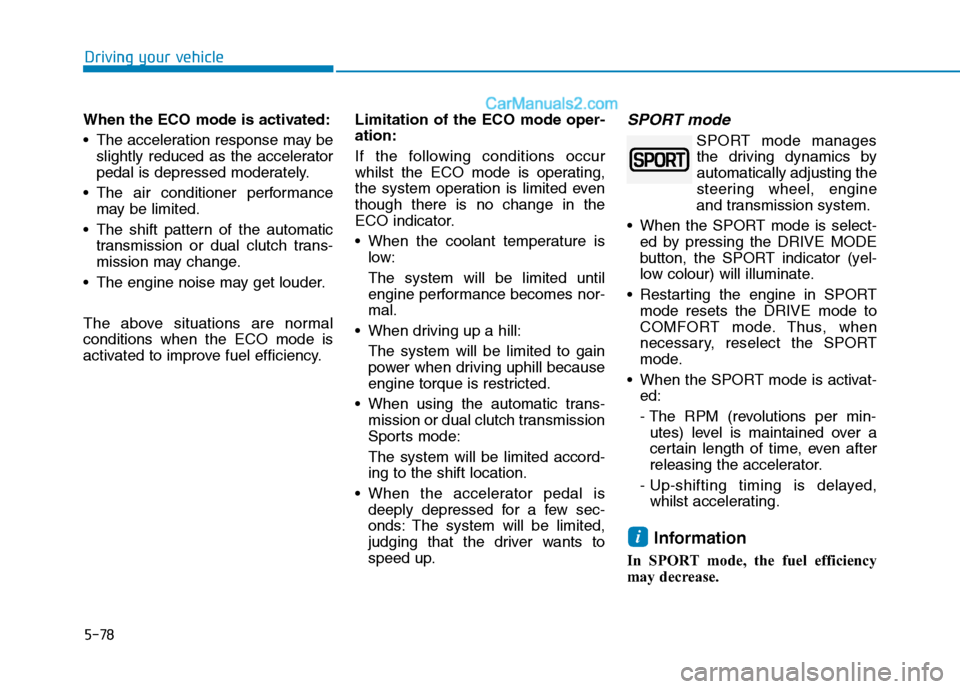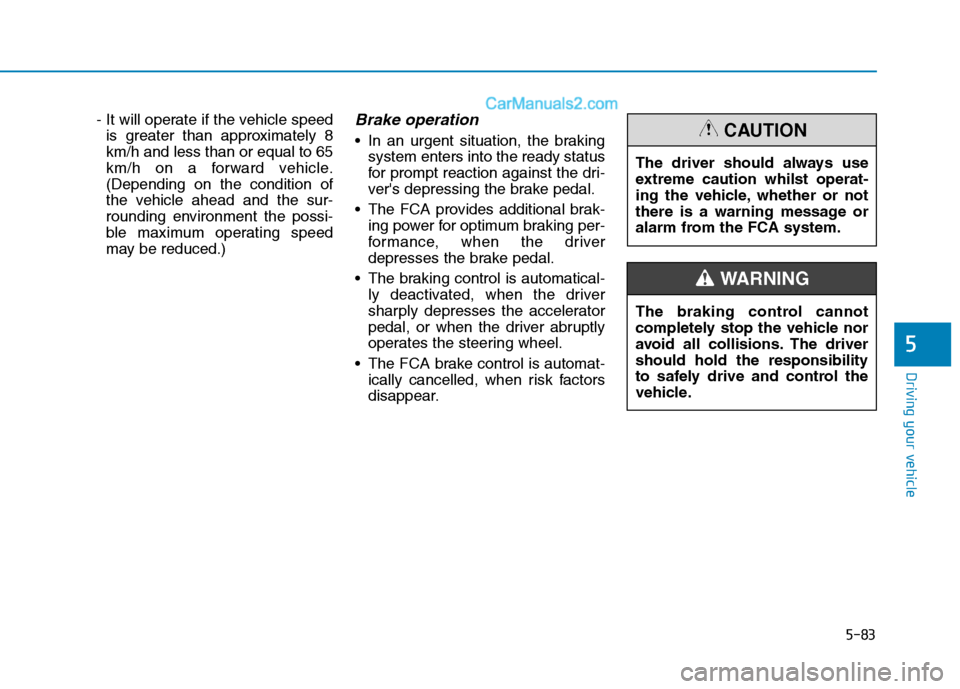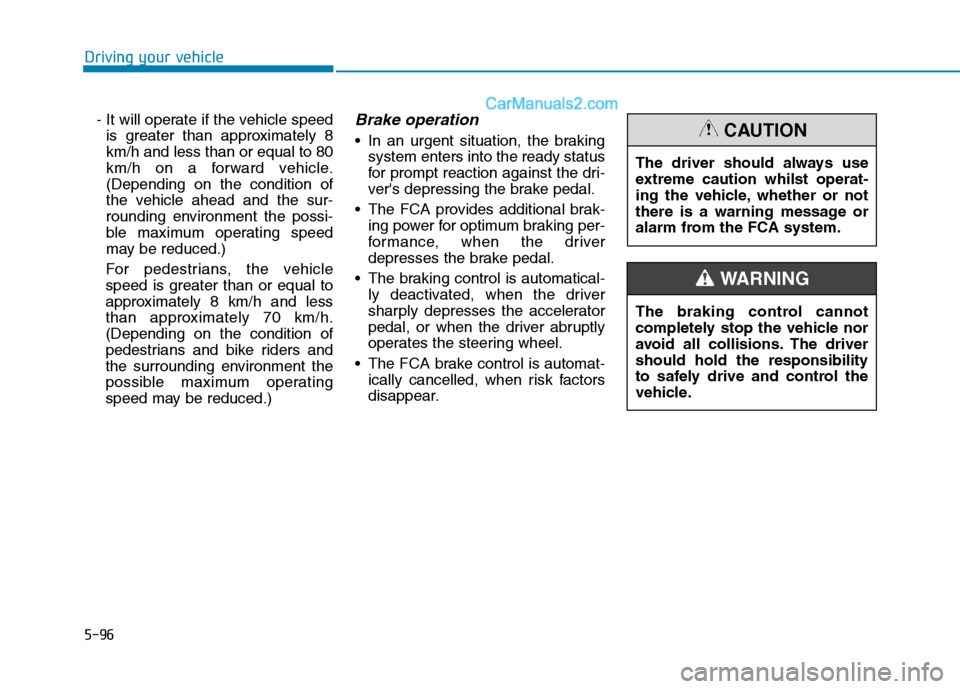Page 386 of 637

5-69
Driving your vehicle
5
Maintain 4WD Auto mode when
driving on roads in normal con-
ditions.
When driving under normal road
conditions (especially when cor-
nering) in 4WD Lock mode, a
driver may find minor mechani-
cal vibration or noise, which is
extremely normal phenomenon,
not a malfunction. When 4WD
Lock mode is released, such
noise or vibration will be imme-
diately gone.
When the 4WD LOCK mode is
deactivated, a sensation may be
felt as the driving power is deliv-
ered entirely to the front wheels.
For safe 4WD operation
Before driving
Make sure all passengers are
wearing seat belts.
Sit upright and closer to the steer-
ing wheel than usual. Adjust the
steering wheel to a position which
is comfortable for you to drive.
Driving on snow-covered or icy
roads
Start off slowly by applying the
accelerator pedal gently.
Use snow tyres or tyre chains.
Keep sufficient distance between
your vehicle and the vehicle in front
of you.
Use engine braking during deceler-
ation.
Avoid speeding, rapid acceleration,
sudden brake applications, and
sharp turns to prevent skids.
NOTICE
NOTICE
When driving on normal roads,
deactivate the 4WD LOCK mode
by pushing the 4WD LOCK but-
ton (4WD LOCK indicator light
goes off). Driving on normal
roads with the 4WD LOCK
mode, especially, when corner-
ing may cause mechanical
noise or vibration. The noise
and vibration will disappear
when the 4WD LOCK mode is
deactivated. Prolonged driving
with the noise and vibration
may damage some parts of the
power train.
CAUTION
Page 393 of 637
5-76
Driving your vehicle
Sport mode
The sport steering mode offers high
steering effort, making the wheel
steering heavier. The sport steering
mode is often used for driving on a
highway.When the driver presses the
steering mode button whilst
driving, it changes the steer-
ing mode option on the LCD
display. However, it does not
immediately change the steer-
ing effort, for your safety.
Upon completing the wheel
steering, the steering tension
is automatically set to the
selected mode.
Pay great caution whilst
changing through modes,
when the vehicle is in motion.
The flex steering wheel does
not operate, when the
Electronic Power Steering
(EPS) does not operate prop-
erly.
CAUTION
OTLE058128
Page 395 of 637

5-78
Driving your vehicle
When the ECO mode is activated:
The acceleration response may be
slightly reduced as the accelerator
pedal is depressed moderately.
The air conditioner performance
may be limited.
The shift pattern of the automatic
transmission or dual clutch trans-
mission may change.
The engine noise may get louder.
The above situations are normal
conditions when the ECO mode is
activated to improve fuel efficiency.Limitation of the ECO mode oper-
ation:
If the following conditions occur
whilst the ECO mode is operating,
the system operation is limited even
though there is no change in the
ECO indicator.
When the coolant temperature is
low:
The system will be limited until
engine performance becomes nor-
mal.
When driving up a hill:
The system will be limited to gain
power when driving uphill because
engine torque is restricted.
When using the automatic trans-
mission or dual clutch transmission
Sports mode:
The system will be limited accord-
ing to the shift location.
When the accelerator pedal is
deeply depressed for a few sec-
onds: The system will be limited,
judging that the driver wants to
speed up.
SPORT mode
SPORT mode manages
the driving dynamics by
automatically adjusting the
steering wheel, engine
and transmission system.
When the SPORT mode is select-
ed by pressing the DRIVE MODE
button, the SPORT indicator (yel-
low colour) will illuminate.
Restarting the engine in SPORT
mode resets the DRIVE mode to
COMFORT mode. Thus, when
necessary, reselect the SPORT
mode.
When the SPORT mode is activat-
ed:
- The RPM (revolutions per min-
utes) level is maintained over a
certain length of time, even after
releasing the accelerator.
- Up-shifting timing is delayed,
whilst accelerating.
Information
In SPORT mode, the fuel efficiency
may decrease.
i
Page 400 of 637

5-83
Driving your vehicle
5
- It will operate if the vehicle speed
is greater than approximately 8
km/h and less than or equal to 65
km/h on a forward vehicle.
(Depending on the condition of
the vehicle ahead and the sur-
rounding environment the possi-
ble maximum operating speed
may be reduced.)Brake operation
In an urgent situation, the braking
system enters into the ready status
for prompt reaction against the dri-
ver's depressing the brake pedal.
The FCA provides additional brak-
ing power for optimum braking per-
formance, when the driver
depresses the brake pedal.
The braking control is automatical-
ly deactivated, when the driver
sharply depresses the accelerator
pedal, or when the driver abruptly
operates the steering wheel.
The FCA brake control is automat-
ically cancelled, when risk factors
disappear.The driver should always use
extreme caution whilst operat-
ing the vehicle, whether or not
there is a warning message or
alarm from the FCA system.CAUTION
The braking control cannot
completely stop the vehicle nor
avoid all collisions. The driver
should hold the responsibility
to safely drive and control the
vehicle.
WARNING
Page 413 of 637

5-96
Driving your vehicle
- It will operate if the vehicle speed
is greater than approximately 8
km/h and less than or equal to 80
km/h on a forward vehicle.
(Depending on the condition of
the vehicle ahead and the sur-
rounding environment the possi-
ble maximum operating speed
may be reduced.)
For pedestrians, the vehicle
speed is greater than or equal to
approximately 8 km/h and less
than approximately 70 km/h.
(Depending on the condition of
pedestrians and bike riders and
the surrounding environment the
possible maximum operating
speed may be reduced.)
Brake operation
In an urgent situation, the braking
system enters into the ready status
for prompt reaction against the dri-
ver's depressing the brake pedal.
The FCA provides additional brak-
ing power for optimum braking per-
formance, when the driver
depresses the brake pedal.
The braking control is automatical-
ly deactivated, when the driver
sharply depresses the accelerator
pedal, or when the driver abruptly
operates the steering wheel.
The FCA brake control is automat-
ically cancelled, when risk factors
disappear.The driver should always use
extreme caution whilst operat-
ing the vehicle, whether or not
there is a warning message or
alarm from the FCA system.CAUTION
The braking control cannot
completely stop the vehicle nor
avoid all collisions. The driver
should hold the responsibility
to safely drive and control the
vehicle.
WARNING
Page 514 of 637

6-26
What to do in an emergency
If a towing service is not available in
an emergency, your vehicle may be
temporarily towed using a cable or
chain secured to the emergency tow-
ing hook at the front (or rear) of the
vehicle.
Use extreme caution when towing
the vehicle with a cable or chain. A
driver must be in the vehicle to steer
it and operate the brakes.
Towing in this manner may be done
only on hard-surfaced roads for a
short distance and at low speeds.
Also, the wheels, axles, power train,
steering and brakes must all be in
good condition.Always follow these emergency tow-
ing precautions:
Place the ignition switch in the
ACC position so the steering wheel
is not locked.
Place the shift lever in N (Neutral).
Release the parking brake.
Depress the brake pedal with more
force than normal since you will
have reduced braking perform-
ance.
More steering effort will be
required because the power steer-
ing system will be disabled.
Use a vehicle heavier than your
own to tow your vehicle.
The drivers of both vehicles should
communicate with each other fre-
quently.
Before emergency towing, check
that the hook is not broken or dam-
aged.
Fasten the towing cable or chain
securely to the hook.
Do not jerk the hook. Apply a
steady and even force. Use a towing cable or chain less
than 5 m long. Attach a white or red
cloth (about 30 cm wide) in the
middle of the cable or chain for
easy visibility.
Drive carefully so the towing cable
or chain remains tight during tow-
ing.
Before towing, check the automat-
ic transmission/dual clutch trans-
mission for fluid leaks under your
vehicle. If the automatic transmis-
sion fluid is leaking, flatbed equip-
ment or a towing dolly must be
used.
OTLE068029
The driver must be in the vehi-
cle for steering and braking
operations when the vehicle is
being towed. Passengers other
than the driver must not be in
the vehicle.
CAUTION
Page:
< prev 1-8 9-16 17-24